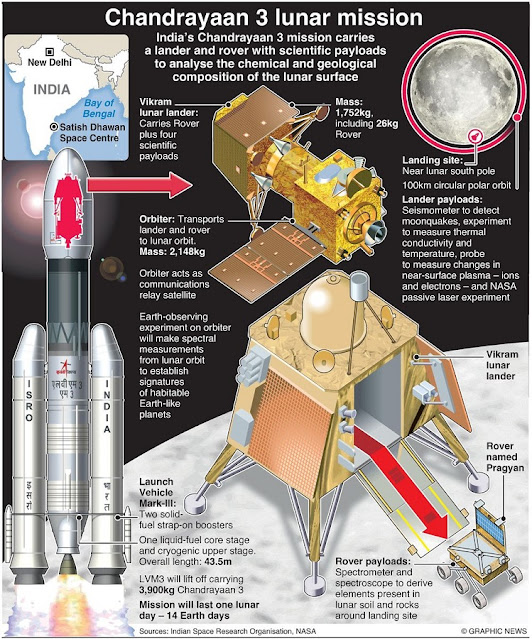As usual - stories that caught my interest that are on the small side.
India launches a lunar lander mission
The Indian Space Research Organisation (ISRO) successfully launched their Chandrayaan-3 lunar landing mission from Satish Dhawan Space Centre, on July 13 at 14:30 local time (09:00GMT) aboard a Launch Vehicle Mark-III or LVM3, India's heaviest lift vehicle. This can be viewed as the first step of their second attempt to do a soft landing on the moon. What?
Liftoff came nearly three years to the date of the launch of the Chandrayaan-2 mission to the Moon. That launch successfully placed a spacecraft into lunar orbit, but a landing attempt was unsuccessful. The Indian space agency, ISRO, lost communication with its Vikram lander at about 2 kilometers above the lunar surface due to a software problem. It subsequently crashed into the Moon.
So the Indian space agency decided to learn from its mistakes and try again. The Chandrayaan-3 mission has eschewed the lunar orbiter, as the Indian spacecraft remains operational after three years. So this launch consisted of a propulsion module, a new Vikram lander, and a small rover named Pragyan.
This is clearly a second attempt at the ambitious mission, but why "the first
step of their second attempt?" Simply because this isn't like a 1960s US
lunar mission that launched directly for the lunar surface and it's going to
take a more circuitous but fuel-efficient route to the moon, as other
satellites are doing these days. See, for example,
Japan's Hakuto-R M1
or the
Peregrine lander
(scheduled for the first Vulcan Centaur Cert-1 flight).
It's scheduled to reach lunar orbit on August 5, setting the stage for a landing attempt as early as August 23. The Vikram lander will attempt to make a soft touchdown in the southern hemisphere at a latitude of about 69 degrees south.
India developed this mission on a budget of $90 million, a rounding error in something like an Artemis launch, so here's hoping they got everything right.
A larger version is available here.
To date, only three nations on Earth have successfully landed on the moon, the US, the Soviet Union and the PRC (China). India is attempting to become the fourth country to do so and is the first of as many as half a dozen missions that will attempt to land on the Moon during the next six months.
Astra is in financial trouble
This week's Rocket Report says the aspiring small launch company is in financial trouble and trying to raise enough capital to continue development of their Rocket 4.0.
Astra is pursuing a capital-intensive development of its new Rocket 4 launch vehicle at a time when its stock price has been on a precipitous decline. Now Astra is planning a "reverse stock split" and is attempting to raise up to $65 million through an offering of common stock, CNBC reports. A reverse split can be seen as a sign a company is in distress and is trying to “artificially” boost its stock price, or it can be viewed as a way for a viable company with a beaten-up stock to continue operations on a public stock exchange.
Astra is short on cash ... In its most recent quarterly financial report released in May, Astra said there was "substantial doubt" about the company's ability to continue. At the time, Astra said its production and operation plans will be scaled back or curtailed if it is unable to raise "substantial additional capital." Astra shelved its Rocket 3 small satellite launch vehicle last year after five failures in seven orbital launch attempts. It's now focusing on development of a larger vehicle called Rocket 4 and spacecraft propulsion systems.
I'll forever think of Astra as the company with the "World's Most Interesting Rocket Flight Abort" in August of '21, with the Rocket going sideways several seconds. After only making orbit twice out of seven attempts they decided in August of '22 to abandon the Rocket 3.3 platform and focus on the Rocket 4.0.
Date set for next Japanese launch
Japan's space agency has set August 26 for the launch of the next H-2A rocket. The H-2A rocket will deploy an astronomy satellite called the X-Ray Imaging and Spectroscopy Mission (XRISM), along with the Smart Lander for Investigating Moon (SLIM) mission in a bid to become the first Japanese spacecraft to achieve a soft landing on the lunar surface.
You will probably remember the failure of the Japanese H3 launch in early March of this year. The H3's upper stage failed to ignite and the H-2A uses a similar engine, so the failure grounded the fleet until it was understood.

This is superb news, as when I'm on the dark side of the moon building telescopes I'll still prefer Indian food to Chinese food. And curvy Indian women, with orbital insertion collision bumpers like mangos.
ReplyDelete(Checks: none of the FCC's seven words in there, still making-family friendly)
... with orbital insertion collision bumpers like mangos??
DeleteNever heard that one before, but I think I understand.
It hadn't occurred to me until sometime in the last couple of months, but the increase in satellite constellations (Starlink, Kuiper and the ones I can't think of) might incentivize building those telescopes on the far side of the moon.
I'd love to see that get started. Telescopes on the moon with a support colony around them.
Sad to see Astra go. Nice to see a lot of companies trying a variety of options. Trained a lot of people. Hopefully the employees will be able to apply what they have learned. Maybe some of them can make a start up to rescue ViaSat-3 Americas?
ReplyDelete